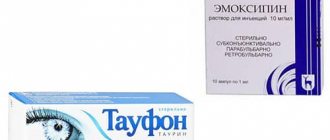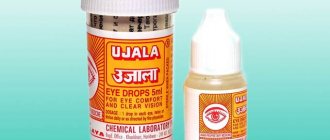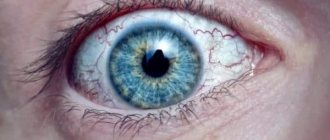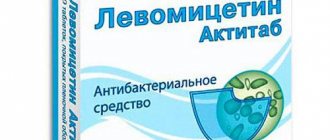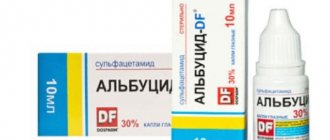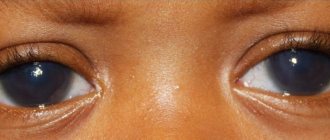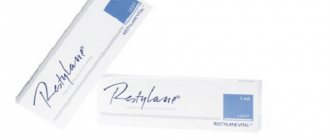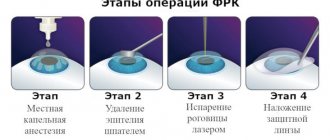Cataract is a disease that occurs as a result of clouding (partial or complete) of the lens of the eye. The disease manifests itself through a decrease in visual acuity, up to its complete loss. The risk group for cataracts is the elderly. But now the disease is increasingly being diagnosed in young people and even in children.
Oftan Catachrom is a remedy for the prevention of cataracts and stopping its development. The medicine is intended for the treatment of adults only. Children and adolescents (up to 18 years of age) are a direct contraindication to its use.
In this review, we will look at what the drug consists of and how it works, and also find out the answers to other important questions about it: how to use the drug, what are the indications for its use, are there any contraindications, are there possible side effects, what can replace Oftan Katahrom . Here we will get acquainted with reviews about the medicine.
What it consists of and how it works
Oftan Katahrom is a combination drug that contains 3 main components:
- Cytochrome C is an antioxidant that has the following actions: minimizes the harmful effects of free radicals on the cornea;
- normalizes redox reactions in the eyeball;
- affects the lens of the eye, preventing the development of cataracts, is practically not absorbed (that is, not absorbed) - when it enters the body, the substance is quickly converted into bilirubin and excreted with bile.
- dilates blood vessels, and, therefore, normalizes microcirculation in the tissues of the eye;
- stimulates the outflow of toxins, promotes blood saturation with oxygen;
- by acting on certain receptors, it neutralizes inflammation in the cornea and conjunctiva;
- improves metabolic processes in the eye lens.
Adenosine and nicotinamide are excreted through the kidneys along with urine.
The medicine also contains additional components: benzalkonium chloride, sorbitol, water, sodium dihydrogen phosphate dihydrate.
Together, all ingredients have the following effects:
- antioxidant;
- nutritious;
- anti-inflammatory;
- disinfectant;
- antibacterial.
The product affects not only the lens, but also all tissues of the eye, preventing and stopping possible infection. The medicine eliminates eye fatigue and moisturizes them.
Caution: Eye drops do not cure cataracts. No medications can eliminate lens clouding.
Such drugs only stop the development of the disease. And the sooner therapy is prescribed, the more effective it will be. Therefore, if signs of cataracts appear (stripes and dots often flashing before the eyes, the appearance of halos around objects, a painful reaction to light, blurred vision), do not delay a visit to an ophthalmologist.
The drug will help stop the course of the disease.
Mechanism of action
Eye drops for cataracts are intended for the treatment of various forms of the disease (age-related, congenital, toxic, secondary). Their action is based on:
- regulation of metabolic processes;
- activation of cellular respiration;
- resorption of protein accumulations;
- acceleration of tissue regeneration;
- manifestation of antimicrobial and anti-inflammatory effect;
- removal of toxins and protection from the negative effects of free radicals on tissues;
- moisturizing the mucous membranes of the eye.
Cataract medications activate restoration and metabolic processes in the structures of the eye. But since clouding of the lens is irreversible, medications only help to slow down the development of the disease. At the same time, to achieve a positive therapeutic effect, the drops must be used for a long time. If the drug no longer has a therapeutic effect, you need to contact an ophthalmologist to select another drug.
Eye drops have a positive effect only in the initial stages of the disease. When the form is advanced, the only way to get rid of cataracts is surgery. However, even on the eve of surgery, the use of drops is necessary to reduce the symptoms of the disease.
All eye drops for cataracts are used for a long time. They have virtually no contraindications or side effects, and therefore are safe even with prolonged use. Generally, restrictions on use concern children and adolescents, pregnant and lactating women, people with allergies to the components included in the preparations.
All such drugs act locally, are not absorbed into the systemic circulation, and therefore are combined with drugs for internal use. However, if there is a need to use other eye drops, the decision about their simultaneous use with cataract medications should be made by the doctor.
Typically, when using several types of drops simultaneously, the time between instillations should be at least 15–20 minutes.
Dosages and application features
Self-treatment with Oftan Katachrom is unacceptable: the drug must be prescribed by a doctor.
To achieve a lasting positive effect, a long course is required - usually about 6 months.
You need to instill it three times a day in a dosage of 1-2 drops in each eye. To do this, follow these steps:
- Wash your hands.
- If you use contact lenses, remove them - you can reinsert the lenses no earlier than 20 minutes after the procedure, otherwise the substances contained in the medicine will damage their material.
- When using for the first time, apply light pressure on the top of the cap when unscrewing it.
- Gently pull back the lower eyelid.
- Drop the required amount of solution into the opened conjunctival sac (the space between the apple and the retracted eyelid).
- Make sure that the tip does not touch the surface of the eye.
- Close your eye and press your eyelid at the bridge of your nose for 20-30 seconds - this way you will compress the tear duct and prevent droplets from flowing through it into the nasal cavity.
If any other medications are prescribed, instill them no earlier than 15 minutes after Oftan Katachroma.
Otherwise, physical leaching of the healing composition is possible.
Application
The instructions for use of this drug recommend using it as follows: daily inject one or two drops of the drug into the conjunctival sac of the affected eye at least three times a day. The duration of treatment with this drug for each patient is determined by the attending physician according to indications. Find out more about the causes, symptoms, treatment and prevention of cataracts in this material.
Application of Oftan Katachroma
There are also special recommendations for the use of this drug. They provide:
- Refusal to drive a vehicle in the first hours after administration of the drug. During this period, a person may experience a temporary deterioration in vision.
- Strict compliance with hygiene standards when using a dropper bottle. A person needs to ensure that the spout of this bottle does not come into contact with anything, otherwise it may become infected.
- Careful handling of contact lenses during treatment with this product. Immediately before the administration of the drug, a person must remove the lenses, and then re-wear them only after administering the drops. If you break this rule, the preservatives included in the drug may be deposited on the lenses.
The main contraindication to taking this drug is individual intolerance to the drug. Also, this medicine is not prescribed to pregnant women and persons under 18 years of age. Find out about the treatment of cataracts in older people in this article.
During pregnancy
This drug is not used to treat pregnant and lactating women, since there is no data on the safety of using such a drug during these periods. This category of patients is prescribed other drugs that have a similar effect for treatment.
For small children
The drug is not recommended for use in patients under 18 years of age. This is due to the fact that doctors do not have reliable data on the safety of this medicine for patients in this age group. More detailed instructions for use with Katachrom drops are here.
Contraindications and side effects
The instructions list contraindications for prescribing the drug:
- individual intolerance to any of the components of the drops;
- age up to 18 years.
Pregnancy and lactation are relative contraindications, since the effect of the drug on the fetus has been little studied. If cataracts are diagnosed in a woman expecting a baby, before prescribing Oftan, the doctor assesses and compares the risks to the health of the mother and child.
Treatment with Oftan Katachrom can cause side effects:
- local - short-term burning and itching in the eyes, blurred vision, hyperemia (redness) of the mucous membrane, development of allergic conjunctivitis;
- systemic - decreased blood pressure, dizziness, nausea, fainting, shortness of breath, skin rashes, facial swelling.
Taufon
The range of application of the drug is very wide, from cardiology to ophthalmological pathologies. Medication is prescribed for pathological conditions:
- retinal dystrophy;
- injuries in the cornea;
- cataracts of any type;
- increased pressure inside the eye cavity;
- rehabilitation period due to surgical intervention;
- inflammation of the conjunctiva and cornea;
- with excessive strain on the visual organs.
The only side effects to Taufon are an allergic reaction. Contraindications to therapy based on the drug include intolerance to the components of the drug and childhood. It is acceptable to prescribe Taufon to nursing mothers and women at the stage of gestation.
Opinions of doctors and patients
Feedback from doctors and patients will provide a more complete understanding of the features and effectiveness of the drug.
Olga Ivanovna Zh., ophthalmologist with 9 years of experience:
“Based on my own practice, I concluded: Oftan Katahrom can stop the progression of cataracts at the very first stages of its development. For small opacities of the lens, medications that dilate the pupil also have a good effect. In general, the only way to treat cataracts is surgery. In this case, the “damaged” lens is replaced with an artificial one.”
Elena Sergeevna P., 59 years old:
“I began to notice that in dim light (in the evening) my visual acuity sharply decreased. I contacted an ophthalmologist. He diagnosed the development of cataracts. Prescribed Oftan Katahrom 2 drops three times a day in each eye. I honestly followed the prescribed plan. But there was no improvement. I had to go for surgery. The right eye was operated on first, and the left eye a month later. About 5 days after surgery, my vision became the same as it was 30 years ago.”
Klavdiya Sergeevna Zh., 63 years old:
“With age, my eyes began to hurt and water, a burning sensation appeared, and visual acuity decreased. The clinic diagnosed cataracts in the initial stages of development. They prescribed Oftan Katahrom and some other medications (including vitamins). Within 6-7 days I noticed obvious improvements. At the next examination, it turned out that the disease had receded. I’m completely satisfied with the medicine, that’s why I’m leaving a positive review.”
Compound
Eye drops have an active composition that helps improve the condition of the lens, restoring its normal functioning.
It should be noted that Oftan Katahrom belongs to the group of antioxidant and nourishing eye products. The drug has 3 main active ingredients that are necessary for the eye tissues. These components include:
- Nicotinamide - promotes accelerated renewal of eyeball tissue. This component stops the development of cataracts by protecting cells from the negative influence of environmental factors. The substance is a compound of nicotinic acids, which are antioxidants that prevent the process of oxidation and tissue damage. The component is characterized by rapid absorption into tissues and is excreted from the body through the kidneys.
- Adenosine - cleanses tissues of toxic accumulations that irritate mucous membranes. Additionally, the substance has a dilating effect on the intraocular vessels and enhances hydration. All this helps to normalize microcirculation in the tissues of the eyeball.
- Cytochrome C - promotes the destruction of an enzyme harmful to the eyes - cytochrome oxidase, which causes injury to the internal cells of the eyes. It is one of the most important components that oxidize, reduce and synthesize ATP, and is also part of the antioxidant mechanism.
All these components of the eye drug are an integral part of the treatment and prevention of many ophthalmological diseases. Their task is to moisturize and disinfect the mucous membrane, as well as speed up the treatment process.
The drug also contains:
- water for injections;
- sodium succinate;
- hydrogen phosphate dihydrate;
- benzalkonium hydrochloride.
All of these are additives that relieve irritation and prevent the development of allergic reactions. Also, additional substances are necessary to facilitate the use of the drug and long-term storage.
Analogs
Oftan Katahrom has no analogues for active substances. But there are medications on pharmacy shelves that have a similar effect.
- Taufon - eye drops based on taurine. The product restores metabolism in eye tissues, improves metabolic reactions, and stimulates regenerative processes. It is prescribed not only for the prevention and treatment of cataracts, but also for the treatment of corneal dystrophy and injuries. The average price of a bottle is 110 rubles.
- Quinax - drops with the main active ingredient azapentacene. Suitable for treating patients under 18 years of age. Prescribed for all types of cataracts. A bottle with a capacity of 15 ml costs an average of 450 rubles.
- Taurine - drops with the active ingredient of the same name (taurine), stimulating the restoration of eye tissue for cataracts of any origin. The average cost of a 5 ml bottle is 50 rubles.
Analogue of Oftan Katachroma - Taurine.
- Catalin - tablets for preparing a solution based on sodium pyrenoxine. Effectively prevents the development of senile cataracts. The average price of a set (blister of tablets and bottle of solvent) is 460 rubles.
Oftan katachrome instructions for use, contraindications, side effects, reviews
A drug for the treatment of cataracts. Drug: OFTAN® CATACHROME Active substance of the drug:
adenosine, cytochrom C, nicotinamide ATC coding: S01XA KFG: Drug used for cataracts Registration number: P No. 015553/01 Registration date: 04/12/04 Registration owner. credential: SANTEN OY {Finland}
Release form Oftan katachrome, drug packaging and composition.
Eye drops in the form of a transparent solution of a reddish color, sour taste.
1 ml cytochrome C 675 mcg adenosine 2 mg nicotinamide 20 mg
10 ml - plastic dropper bottle (1) - cardboard packs.
The description of the drug is based on the officially approved instructions for use. pharmachologic effect
A drug for the treatment of cataracts. It has an antioxidant effect, improves metabolism and trophism of eye tissue. Cytochrome C is a high-molecular iron porphyrin compound, which is isolated in the form of a purified crystalline substance, for example, from the myocardium of cattle. It is a conjugated protein, similar in structure to hemoglobin, consisting of heme and a single peptide chain (apocytochrome C). Cytochrome C plays a critical role in biochemical redox processes in almost all aerobic organisms. These reactions occur with the participation of two mitochondrial enzymes - cytochrome oxidase and cytochrome reductase. Heme exhibits the properties of either an electron donor or an electron acceptor. It is highly reactive to scavenging oxygen radicals such as superoxide or hydrogen peroxide, which is a strong oxidizing agent. Heme metabolites act as scavengers for the peroxide radical. It has been proven that in the lens affected by cataracts, the concentration of cytochrome C is reduced. Cytochrome C is not able to penetrate the cornea in sufficient quantities as a whole molecule. This becomes possible only after cleavage of the peptide chain into a heme-containing nanopeptide, which freely penetrates into the cornea. Inhibition of oxidative processes in all tissues anterior to the lens (including the cornea and intraocular fluid) is of great importance in suppressing the development of cataracts, since ultraviolet radiation causes chain reactions in these tissues with the formation of free oxygen radicals, which have been proven , can lead to clouding of the lens. Heme-containing cytochrome C has the ability to neutralize free oxygen radicals in certain redox processes and thus prevent the development of cataracts. Adenosine is the main element for DNA and RNA repair, as well as a structural element of these molecules, participates in the processes of energy metabolism, and is a paracrine regulator. The vast majority of cataract cases are associated with lens degeneration. DNA repair in the lens epithelium is necessary to restore damage caused, for example, by the damaging effects of oxidation. This requires the presence of adenosine. Due to its vasodilating effect and increased ocular blood supply, adenosine helps flush out toxic waste products, stimulating the production and exchange of intraocular fluid. Adenosine reduces inflammation in the conjunctiva, cornea and other eye tissues; indirectly affects the restoration of glutathiones, since it is a structural element of the enzyme glutathione reductase and reduced NADP, which are necessary to activate the main protective mechanism for suppressing oxidation processes in the lens. Nicotinamide is a structural element of NAD and NADP and is broken down by nicotinamidase to form nicotinic acid. It is believed that nicotinamide promotes the regeneration of endothelial cells of the lens, which helps prevent the development of cataracts. In addition to the therapeutic effect for cataracts, the drug has an anti-inflammatory, antimicrobial and moisturizing effect on the surface of the eye.
Summary
Oftan Katahrom is a combination drug in the form of eye drops intended for the prevention and treatment of cataracts. Suitable for treatment of adult patients only. Advantages of the medicine:
- effectiveness and rapid manifestation of results (if prescribed in a timely manner);
- a small number of contraindications;
- complex action - not only stops the development of cataracts, but also prevents infection;
- low risk of developing serious side effects.
Minuses:
- relatively high cost;
- the impossibility of treating children and adolescents under 18 years of age with the drug;
- When instilled, a short-term burning sensation appears in the eyes.
Natalia Roy
Oftan Katahrom
Stimulator of restoration of endothelial tissue of the lens, activating metabolic processes. Due to the adenosine contained in Oftan Katahrom, it has a vasodilating effect and stimulates the synthesis of intraocular fluid. The drops also have an antibacterial effect, preventing the development of inflammatory processes in the eye structures.
Oftan Katahrom is produced in Finland and has been widely used by ophthalmologists in Russia for more than 10 years as a means of slowing the development of cataracts. The drug is produced in the form of eye drops that do not require dilution and is easy to use. In addition to cytochrome C, a powerful antioxidant, the drops contain the energy source adenosine and the vitamin nicotinamide. Such a combined composition provides a clinically proven effect on the development of cataracts.
The main component of the drops, cytochrome C, slows down and in some cases suppresses the process of lens opacification. The drug is used for cataracts of various origins, as well as for the purpose of prevention.
Features of therapy:
- Occasionally, short-term dizziness and arterial hypotension are possible.
Directions for use: 1-2 drops 3 times a day.
Price: ~360 rub.
Side effects
In some cases, there may be signs of eye irritation, but this side effect usually goes away quickly.
More serious consequences of instillations of Oftan Katachroma are nausea, shortness of breath, hypotension and dizziness (such effects appear due to intolerance to the nicotinic acid contained in the medicine).
People with a predisposition to allergic reactions to medications in the upper and lower eyelids may develop contact dermatitis, as well as redness of the conjunctival membrane of the eye.
In some cases, any of these phenomena may be isolated and no longer appear during subsequent instillations.
But if such signs become permanent, instillations of oftan katachrome are canceled, and the attending physician selects another remedy with a similar effect.
